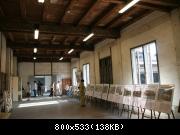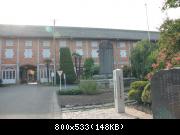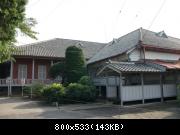Location : Tomioka Silk Mill (富岡製糸場)
Prefecture : Gunma-ken
Attractions : Japan's oldest modern model silk reeling factory, established in 1872 with the help of French specialists. It is also the only factory established by the Meiji government in the 1870s that has been preserved.
 Opening Time :
Opening Time : 9:00am - 5:00pm (reception closes at 4:30pm); there are free tours (duration : 50 minutes) starting at 10:00am, 11:00am, 1:00pm, 2:00pm, 3:00pm, 4:00pm (the latter only from April to September)
Price : 500 yen
Address : Tomioka-shi, Gunma-ken
Access : check
this link for details and maps
train - go first to Takasaki (by shinkansen or normal JR train), and then take the Joshin Elc. Railroad to Joshu-Tomioka (37 min, 770 yen); the place is 1 km from the station.
car - from Tokyo, take the highway toward Nagano and exit at Tomioka I.C.; It is a short 3 km trip to the place.
Internet : http://www2.city.tomioka.lg.jp/worldheritage/en/index.html
Phone : 0274-62-1511
T RED
Tomioka Silk Mill
rail
Joshu-Tomioka station
History
In the movie
The Last Samurai, Tom Cruise is impersonating a US soldier invited to Japan at the beginning of the Meiji Restoration to teach Japanese how to build a modern army... While the movie takes some liberty with historical realities (as usual !), it was indeed a period when foreigners - from Europe and USA - were brought to Japan to help modernize the country.
Among them was Paul Brunat, who was working for a French trading company in Yokohama. At Japanese government request, he started to search a good location to build a silk mill in the Kanto area. At that time, Japan was exporting a lot of raw silk, but was lacking the technique to produce large amount of good quality silk. Paul Brunat finally selected Tomioka city for four main reasons:
- Supply of silk moths was abundant in the area
- Land was available to build a factory on a large surface
- Coal was found in quantity in near-by Takasaki city
- Tomioka had a river that could be used for the production
The silk manufacturing factory was established in 1872 (Meiji 5). It was a national government-operated factory, built under the Japanese government policy to encourage new industry. The beginnings were rather difficult, as it was especially hard to find female workers who wanted to work in the plant; indeed, since its construction, some rumors were surrounding the silk mill, including the one that the foreigners were drinking the blood of the young ladies working there. This unusual belief was not due to any vampire legend, but only to the fact that French engineers were drinking red wine they imported with them! To kill that rumor, the governor of the province sent his daughter to work there, followed by daughters of other important personalities.
When those women returned to their home after a 2 or 3-years training, they then became trainers in silk manufacture in their own prefectures, thus spreading the knowledge acquired from the French. Indeed, in 1909, Japan was the world's largest exporter of raw silk. Among those women was
Wada Ei (1857-1929), daughter of samurai Sinshu Matsushiro, who wrote "Tomioka Diary" (
Tomioka Nikki) in which she chronicled her life in the silk mill.
Together with the good working conditions (8 hours per day instead of the usual 12 hours, 1 rest day per week), the care taken of the employees (a small hospital was built together with the factory), the presence of those daughters of important persons quickly create an emulation, and the Tomioka silk mill became very popular. 350-500 women were operating the machines of the factory.
The French staff stayed on site the first 4 years of operation, before being discharged in 1976. It was supposed that the financial burden of hiring foreign supervisors rendered the factory not profitable. Even after the dismissal, the Tomioka silk mill continued to be always in the red, and the governement finally decided to privatize it in 1893. It continued to operate until 1987, when the factory was finally closed down. It was finally closed in 1987, when its value as a cultural and historical site started to be evaluated. In 2005, it was designated as a historical site, and in 2007, the site was registered on the
UNESCO Tentative List, the step allowing a future registration as a UNESCO World Heritage site.
Visit
You can either visit the premises by yourself, or take a free tour starting every hour (see above); this tour in only in Japanese, does not visit places you can not go by yourself but can be quite informative if you understand the language.
Two buildings can be visited, while the others can only be seen from outside - unfortunately.
 East Cocoon Warehouse (東繭倉庫)
East Cocoon Warehouse (東繭倉庫)
First building seen by visitors, as it is located just in front of the main entrance, this large warehouse (12m × 104m) is constructed in an original style, copying with some modification the French construction techniques. Bricks are framed with wooden beams. And while only bricks of same size are used, but they are placed alternatively on their large and small size; since those size have a 2:1 ratio, it creates a typical design which is often found in Europe, but virtually unknown in Japan.
The first part of the silk production was taken on the second floor of that building.
The silk comes from cocoons built by silk moth pupae, who were grew up in that building. For 6 weeks, the pupae ("silkworms") eat mulberry leaves, when it reaches a length of 7.5 cm, it starts to build its cocoon made of one silk filament; this process takes 3 days, and the length of the filament produced reaches almost 1000 meters! Before the moth hatches, it is killed by hot water or vapor to preserve the cocoon. The cocoon were then transfered to the Manufacturing Plant building.


 Manufacturing Plant (繰糸場)
Manufacturing Plant (繰糸場)
The largest building (12.3m×140m), where the production of silk thread was made. The process is quite simple... at least theoretically. Cocoons are brushed to get some filaments, which are joined together and wound on a wheel. To produce 1 kg of raw silk, around 5500 cocoons are required.
The great think in that building is that the silk reeling machines used for the production are still there, and can be observed in details (they are unfortunately covered with some transparent plastic sheets, probably to preserve them better). A TV screen presents a 3-minutes movie to describe all steps in details. There are about 7 production lines - all looking quite similar - in that building.
 Brunat House
Brunat House
This elegant building was used by Paul Brunat himself, and later became a cultural center. Visitors can not go inside, though... In the immediate vicinity is the doctor's office, as well as a small hospital.
West Cocoon Warehouse (西繭倉庫)
Another large warehouse - which has the same dimension as the East one. Again visitors are not allowed inside, but can appreciate the size from outside. In this building, the moths were nursed on the upper floor, while coal was stored on the ground floor.
 Administrative Buildings
Administrative Buildings
Built only 1 year after the factory itself, those buildings are much more elegant - a clear sign that the construction techniques improved during this small laps of time.
Video
A small video from youtube showing an abstract of a TV program, in Japanese, dedicated to that silk mill.
Links
Wikipedia : Tomioka silk mill
UNESCO Tentative List : The Tomioka Silk Mill and Related Industrial Heritage
Gunma Prefecture, official site : Check the "Industrial Heritage", in English, for details of other related industrial heritage sites
The History of Silk : A good text to learn more about the silk making process.
(those links provided background to write this guide)